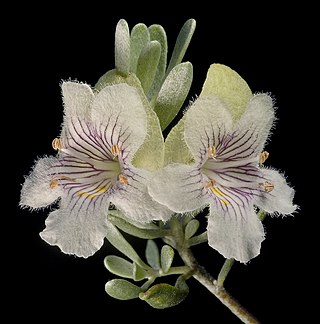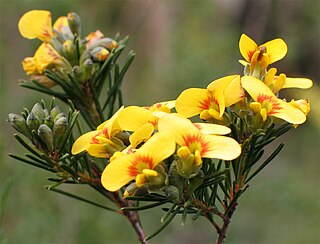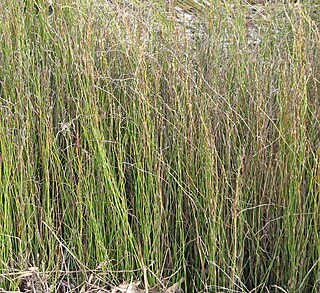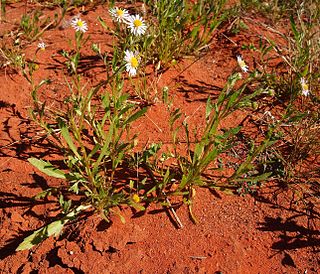
Leptospermum is a genus of shrubs and small trees in the myrtle family Myrtaceae commonly known as tea trees, although this name is sometimes also used for some species of Melaleuca. Most species are endemic to Australia, with the greatest diversity in the south of the continent, but some are native to other parts of the world, including New Zealand and Southeast Asia. Leptospermums all have five conspicuous petals and five groups of stamens which alternate with the petals. There is a single style in the centre of the flower and the fruit is a woody capsule.

Leucopogon is a genus of about 150-160 species of shrubs or small trees in the family Ericaceae, in the section of that family formerly treated as the separate family Epacridaceae. They are native to Australia, New Zealand, New Caledonia, the western Pacific Islands and Malaysia, with the greatest species diversity in southeastern Australia. Plants in this genus have leaves with a few more or less parallel veins, and tube-shaped flowers usually with a white beard inside.

Prostanthera, commonly known as mintbush or mint bush, is a genus of about 100 species of flowering plants in the mint family Lamiaceae, and all are endemic to Australia. Plants are usually shrubs, rarely trees with leaves in opposite pairs. The flowers are arranged in panicles in the leaf axils or on the ends of branchlets. The sepals are joined at the base with two lobes. The petals are usually blue to purple or white, joined in a tube with two "lips", the lower lip with three lobes and the upper lip with two lobes or notched.

Pimelea, commonly known as rice flowers, is a genus of plants belonging to the family Thymelaeaceae. There are about 150 species, including 110 in Australia and 36 in New Zealand.

Patersonia, is a genus of plants whose species are commonly known as native iris or native flag and are native to areas from Malesia to Australia.

Dillwynia is a genus of about 20 species of flowering plants in the family Fabaceae, and is endemic to Australia. Plants in this genus are shrubs with simple leaves and yellow or red and yellow flowers similar to others in the family.

Cassinia is a genus of about fifty-two species of flowering plants in the family Asteraceae that are native to Australia and New Zealand. Plants in the genus Cassinia are shrubs, sometimes small trees with leaves arranged alternately, and heads of white, cream-coloured, yellow or pinkish flowers surrounded by several rows of bracts.

Isotoma is a genus of annual and perennial herbs in the family Campanulaceae and are native to Australia and New Zealand.

Hovea is a genus of about forty species of flowering plants in the family Fabaceae, and is endemic to Australia. Plants in this genus are sub-shrubs, shrubs or small trees with simple leaves and purple, blue or mauve flowers with a white centre. The fruit is a pod containing brown to blackish seeds. Species of Hovea occur in all Australian states, the Australian Capital Territory and the Northern Territory.

Gompholobium, commonly known as glory peas or wedge-peas, is a genus of plants in the pea family Fabaceae and is endemic to Australia. Most species have compound leaves composed of three leaflets and all have ten stamens which are free from each other and a distinctive arrangement of their sepals.

Bossiaea is a genus of about 78 species of flowering plants in the pea family Fabaceae and is endemic to Australia. Plants in this genus often have stems and branches modified as cladodes, simple, often much reduced leaves, flowers with the upper two sepal lobes larger than the lower three, usually orange to yellow petals with reddish markings, and the fruit a more or less flattened pod.

Lasiopetalum, commonly known as velvet bushes, is a genus of about forty-five species of flowering plants in the family Malvaceae, all endemic to Australia.

Daviesia, commonly known as bitter-peas, is a genus of about 130 species of flowering plants in the family Fabaceae, and is endemic to Australia. Plants in the genus Daviesia are shrubs or small trees with leaves modified as phyllodes or reduced to scales. The flowers are arranged singly or in groups, usually in leaf axils, the sepals joined at the base with five teeth, the petals usually yellowish with reddish markings and the fruit a pod.

Lepidosperma is a genus of flowering plant of the family Cyperaceae. Most of the species are endemic to Australia, with others native to southern China, southeast Asia, New Guinea, New Caledonia and New Zealand.

Styphelia is a genus of shrubs in the family Ericaceae, native from Indo-China through the Pacific to Australia. Most have minute or small leaves with a sharp tip, single, tube-shaped flowers arranged in leaf axils and with the ends of the petals rolled back with hairs in the inside of the tube.

Lepyrodia is a plant genus in the family Restionaceae, described as a genus in 1810.

Vittadinia is a genus of Australian and New Zealand plants in the tribe Astereae within the family Asteraceae.
Cycnogeton alcockiae, also known as southern water-ribbons, Alcock's water-ribbons or dwarf water-ribbons, is a plant in the arrowgrass family native to south-eastern Australia, where it has been recorded from South Australia, Tasmania and Victoria. It is found in freshwater and brackish wetland communities, in pools, swamps and the margins of streams, where it grows to about 20 cm in height. The fruit is a papery capsule.

















